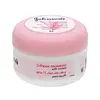What's inside
What's inside
 Key Ingredients
Key Ingredients

No key ingredients
 Benefits
Benefits

 Concerns
Concerns

 Ingredients Side-by-side
Ingredients Side-by-side

Water
Skin ConditioningCyclopentasiloxane
EmollientGlycerin
HumectantDimethicone
EmollientCaprylic/Capric Triglyceride
MaskingGlyceryl Stearate
EmollientPEG-100 Stearate
Cow Blood Clot Extract
Skin ConditioningButyrospermum Parkii Butter
Skin ConditioningStearyl Alcohol
EmollientIsohexadecane
EmollientPropylene Glycol
HumectantSodium Acrylate/Sodium Acryloyldimethyl Taurate Copolymer
Emulsion StabilisingC10-30 Alkyl Acrylate
Polysorbate 80
EmulsifyingPropylparaben
PreservativeSodium Hydroxide
BufferingPhenoxyethanol
PreservativeMethylparaben
PreservativeParfum
MaskingWater, Cyclopentasiloxane, Glycerin, Dimethicone, Caprylic/Capric Triglyceride, Glyceryl Stearate, PEG-100 Stearate, Cow Blood Clot Extract, Butyrospermum Parkii Butter, Stearyl Alcohol, Isohexadecane, Propylene Glycol, Sodium Acrylate/Sodium Acryloyldimethyl Taurate Copolymer, C10-30 Alkyl Acrylate, Polysorbate 80, Propylparaben, Sodium Hydroxide, Phenoxyethanol, Methylparaben, Parfum
Water
Skin ConditioningGlycerin
HumectantParaffinum Liquidum
EmollientEthylhexyl Stearate
EmollientDimethicone
EmollientNiacinamide
SmoothingSucrose Stearate
EmollientGlyceryl Dibehenate
EmollientFructooligosaccharides
HumectantMannitol
HumectantXylitol
HumectantRhamnose
HumectantLaminaria Ochroleuca Extract
Skin ConditioningPeumus Boldus Leaf Extract
MaskingZanthoxylum Bungeanum Fruit Extract
Skin ConditioningTribehenin
EmollientPentylene Glycol
Skin ConditioningGlyceryl Behenate
EmollientAcrylates/C10-30 Alkyl Acrylate Crosspolymer
Emulsion Stabilising1,2-Hexanediol
Skin ConditioningCaprylyl Glycol
EmollientAmmonium Acryloyldimethyltaurate/Vp Copolymer
Caprylic/Capric Triglyceride
MaskingOleyl Alcohol
EmollientXanthan Gum
EmulsifyingSodium Hydroxide
BufferingDisodium EDTA
Water, Glycerin, Paraffinum Liquidum, Ethylhexyl Stearate, Dimethicone, Niacinamide, Sucrose Stearate, Glyceryl Dibehenate, Fructooligosaccharides, Mannitol, Xylitol, Rhamnose, Laminaria Ochroleuca Extract, Peumus Boldus Leaf Extract, Zanthoxylum Bungeanum Fruit Extract, Tribehenin, Pentylene Glycol, Glyceryl Behenate, Acrylates/C10-30 Alkyl Acrylate Crosspolymer, 1,2-Hexanediol, Caprylyl Glycol, Ammonium Acryloyldimethyltaurate/Vp Copolymer, Caprylic/Capric Triglyceride, Oleyl Alcohol, Xanthan Gum, Sodium Hydroxide, Disodium EDTA
Ingredients Explained
These ingredients are found in both products.
Ingredients higher up in an ingredient list are typically present in a larger amount.
This ingredient is an emollient, solvent, and texture enhancer. It is considered a skin-softener by helping the skin prevent moisture loss.
It helps thicken a product's formula and makes it easier to spread by dissolving clumping compounds.
Caprylic Triglyceride is made by combining glycerin with coconut oil, forming a clear liquid.
While there is an assumption Caprylic Triglyceride can clog pores due to it being derived from coconut oil, there is no research supporting this.
Learn more about Caprylic/Capric TriglycerideDimethicone is a type of synthetic silicone created from natural materials such as quartz.
What it does:
Dimethicone comes in different viscosities:
Depending on the viscosity, dimethicone has different properties.
Ingredients lists don't always show which type is used, so we recommend reaching out to the brand if you have questions about the viscosity.
This ingredient is unlikely to cause irritation because it does not get absorbed into skin. However, people with silicone allergies should be careful about using this ingredient.
Note: Dimethicone may contribute to pilling. This is because it is not oil or water soluble, so pilling may occur when layered with products. When mixed with heavy oils in a formula, the outcome is also quite greasy.
Learn more about DimethiconeGlycerin is already naturally found in your skin. It helps moisturize and protect your skin.
A study from 2016 found glycerin to be more effective as a humectant than AHAs and hyaluronic acid.
As a humectant, it helps the skin stay hydrated by pulling moisture to your skin. The low molecular weight of glycerin allows it to pull moisture into the deeper layers of your skin.
Hydrated skin improves your skin barrier; Your skin barrier helps protect against irritants and bacteria.
Glycerin has also been found to have antimicrobial and antiviral properties. Due to these properties, glycerin is often used in wound and burn treatments.
In cosmetics, glycerin is usually derived from plants such as soybean or palm. However, it can also be sourced from animals, such as tallow or animal fat.
This ingredient is organic, colorless, odorless, and non-toxic.
Glycerin is the name for this ingredient in American English. British English uses Glycerol/Glycerine.
Learn more about GlycerinSodium Hydroxide is also known as lye or caustic soda. It is used to adjust the pH of products; many ingredients require a specific pH to be effective.
In small amounts, sodium hydroxide is considered safe to use. However, large amounts may cause chemical burns due to its high alkaline.
Your skin has a natural pH and acid mantle. This acid mantle helps prevent harmful bacteria from breaking through. The acid mantle also helps keep your skin hydrated.
"Alkaline" refers to a high pH level. A low pH level would be considered acidic.
Learn more about Sodium HydroxideWater. It's the most common cosmetic ingredient of all. You'll usually see it at the top of ingredient lists, meaning that it makes up the largest part of the product.
So why is it so popular? Water most often acts as a solvent - this means that it helps dissolve other ingredients into the formulation.
You'll also recognize water as that liquid we all need to stay alive. If you see this, drink a glass of water. Stay hydrated!
Learn more about Water